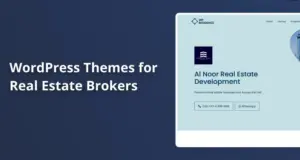Internet Data Exchange, or IDX, is the system that lets real estate agents show MLS listings on their own websites. For WordPress users, that usually means installing a vendor plugin or working with a theme integration that connects to the MLS feed so listings appear as regular pages on your site.
With IDX, your website transcends from a basic brochure site to a dynamic property search hub, all under your unique branding. Visitors can seamlessly search, filter, and view property details without leaving your domain, enhancing their experience and your site’s functionality.
Many agents hear that this is a “must-have” and rush to add it. Others point out that the price, the setup work, and large portals already attract most consumer traffic.
The decision to integrate IDX is not one to be taken lightly. It hinges on how your business generates leads, the amount of traffic you can drive to your site, and your ability to handle the technical and compliance aspects of a live MLS feed. This guide will walk you through these crucial considerations, in the context of WordPress, to help you make an informed decision.
Is IDX Search a Standard Feature on Real Estate Websites?
In daily practice, IDX is widely used as a standard on modern realtor sites. Most buyers start online, and a significant share expect to run a search as soon as they land on an agent’s website.
If there’s no search box, many people will back out and try a competitor who offers one. Younger buyers who grew up with map-based apps also want fast filters, clean cards, and familiar mobile layouts. A WordPress site without these basics can come across as dated compared to others in the same market.
That said, “standard” does not mean “mandatory” in every case. While IDX is widely used as a standard on modern realtor sites, an agent with limited web traffic won’t see much use from a rich MLS search, no matter how polished. Adding Ithis system is like putting a shiny storefront on a quiet side street if your site gets only a handful of visits a week.
It looks good, but almost no one walks in. Some agents prefer to focus on niche pages, referral funnels, or social campaigns that send leads straight to consult calls. For them, IDX may be better as a later-stage add when traffic and budget justify the spend.
This is why the right question isn’t “Is IDX standard?” but “Is IDX standard for sites like mine?” Teams, brokerages, and established agents with steady traffic tend to benefit. New sites, narrow niches, and solo agents without a plan to bring visitors may not.
Lead Generation Benefits of IDX
When used as a lead system, IDX can significantly boost client engagement. The data draws visitors in, but the lead capture turns views into valuable contacts. In WordPress, the plugin inserts search pages and property pages that seamlessly match your theme, enhancing the user experience.
Users create accounts to save searches, favorite homes, and set alerts. Each action gives you contact details and preferences. Over time, you see price bands, neighborhoods, and features that visitors keep returning to. That’s real context for follow-up, not just a cold email.
A person who saves a search for three-bedroom homes in a particular school zone at a set price signals intent. When a matching listing hits the feed, your alert goes to that inbox under your brand. On portals, that same inquiry might ping multiple agents at once.
It routes to your site. That single shift from others’ turf to yours often raises reply rates because buyers already feel anchored to your site. They used your tools, not a generic portal page, to find the property.
The carry-on effect shows up in repeat visits. Once people save searches, they return to check what’s new, which raises session counts and time on site. Those extra touchpoints mean more chances to offer showings or answer questions. They also increase the odds that your name is top-of-mind when buyers are ready to tour. This continuous engagement can lead to more conversions and a higher return on your IDX investment.
None of this works without visibility. If few people visit, the best capture form won’t fill itself. But where traffic exists, IDX becomes the on-site “engine” that keeps visitors engaged long enough to hand you a real lead.
SEO Impact of IDX Integration
From an real estate SEO angle, IDX cuts both ways. On the positive side, a steady feed of listings adds fresh pages that use local signals by default: neighborhood names, postal codes, schools, and nearby landmarks.
Search engines respond well to consistent, structured content like this, and over time, these pages can bring in long-tail queries that big portals don’t fully cover. Agents can also create landing pages that pre-filter results—think “Homes for Sale in [Subdivision] Under $500k”, and link those pages from posts, menus, and local guides.
The catch is in the integration method. If listings are shown through an HTML iframe dropped into your WordPress pages, the content inside that frame lives on a vendor server and is treated as external. The page on your domain gets little or no credit for the feed content. The same problem shows up when results live on a vendor subdomain.
To gain SEO upside, listings should be rendered as real HTML on your site so titles, meta descriptions, and URLs are under your control, and your sitemap can include those pages. That’s what most modern IDX plugins and API-based solutions aim to provide inside WordPress.
Even with indexable pages, you’re not likely to outrank national portals for broad searches like “homes for sale [city].” The realistic path is to target specific neighborhoods, price ranges, building types, or features. Local guides, school pages, and short “what’s new this week” notes that link into filtered searches can help.
Page speed also matters. Photo-heavy listing grids can bog down a page, so compressing images and lazy-loading media inside your theme will help keep Core Web Vitals in line if your IDX plugin outputs schema where allowed, which can support more prosperous snippets, but even without that, clean markup and fast loads do a lot of the heavy lifting.
The big idea is simple: an IDX that outputs indexable content and plays well with your theme allows your site to pick up local, specific searches. An system that hides content inside frames offers almost none of that benefit.
User Experience Advantages
From a buyer’s seat, a site with IDX feels complete. You can search the full inventory without bouncing between tabs, draw a map around the blocks you like, and see details quickly.
A solid IDX plugin in WordPress should inherit your fonts, colors, and spacing so the search feels like it belongs, not like a bolt-on. When the styling is consistent and the map responds without lag, people stay longer and try more filters. That’s part usability, part trust. The site looks like it was built carefully, so visitors are more comfortable sending an email to save a search.
Accuracy also builds trust. MLS feeds update often, so what a buyer sees on your pages tends to be current. Many have used portals where a home looked perfect, only to learn it sold days ago. When your pages avoid that headache, your brand gets credit for reliability.
This difference matters even more on mobile. Most buyers check listings on phones while commuting or between errands. If a card layout loads quickly, buttons are sized well for thumbs, and photos swipe without stuttering, people return the next day and do it again.
The interface itself nudges action. A clear “Schedule a Tour” or “Ask a Question” call-to-action right next to the photo gallery meets buyers where they already are. They don’t need to hunt for your contact page. Small friction cuts add up to more inquiries for the same number of visits.
Downsides and Limitations of IDX
Costs come first. Quality IDX vendors charge setup fees and recurring subscriptions; you still have your MLS dues. Pulling data from multiple MLS means you’ll pay more and manage more moving parts. That’s the baseline math before ads, content work, or developer time.
The technical setup sits next. An IDX is not a single switch. You’ll need to meet your MLS display rules, showing specific fields, including required disclaimers, and refreshing on a set schedule. If you change themes, update WordPress, or swap caching plugins, you may need to adjust templates so pages keep rendering cleanly. Agents often lean on vendors or developers for this. That dependence isn’t bad, but it does mean you respond to their timelines when something breaks.
There’s also a strategic ceiling if traffic is low. A polished search on a site with little reach won’t produce steady leads. That leads some agents to judge IDX as “ineffective,” when the real issue is top-of-funnel volume. Conversely, even with traffic, a cookie-cutter IDX can blunt your brand. If ten agents in your area use the same default templates, their sites feel interchangeable.
People often forget which one they used yesterday. While matching styles, tuning layouts, and adding context around listings can avoid this, many skip those steps and lose the chance to stand out.
Last, the integration method can undercut the very gains you expect. If your vendor places results on a subdomain or inside frames, your site gains little search value from all those pages. Analytics can be messy for the same reason. Click paths through framed content don’t always show up where you expect, which makes it harder to see what users actually do and where they drop off.
Pros and Cons of IDX Search Integration
Think of the gains in two buckets: engagement and visibility. Engagement increases when visitors can run full searches without leaving, when the interface is fast and clean, and when saved searches bring them back. Visibility improves when the IDX outputs indexable pages with local terms matching people’s search preferences.
Lead capture lives between these two buckets. A visitor who can search widely on your domain and then save settings is likelier to hand over an email, which most agents want.
Trade-offs are clear. You commit to ongoing fees and setup, compliance, and maintenance work. You accept that an IDX won’t outrank portals on broad terms and plan for local, specific targets instead. You also acknowledge that default templates make your site look like others until you customize them.
The SEO case weakens if your vendor uses frames or a separate host for results. If your site has little traffic, the lead case weakens. Those are real limits, not deal breakers, and they help you decide timing.
Seen this way, IDX is neither a magic lead switch nor a waste of money. It’s a tool that pays off when tied to traffic, tuned to your brand, and integrated in a way that helps search engines see the content as yours.
For many WordPress realtor sites, IDX has become the expected baseline. Buyers want to search immediately and enjoy that search to feel quick, clean, and current. When you offer that on your domain, you keep people around longer, make it easier to ask for a tour or details, and build trust through accurate data. If you already run paid campaigns, publish local content, or rank for neighborhood terms, an IDX turns those visits into more saved searches and more contacts you can follow up with in a focused way.
Not every site is ready on day one. You can delay without penalty if your traffic is thin, your budget is tight, or your plan is still forming. During that time, build pages highlighting neighborhoods, answering local buyer questions, and showing proof of work.
When visits rise and you’re ready to plug in a search, pick an IDX that outputs indexable content as real HTML, matches your theme without breaking layouts, and passes leads straight into your follow-up system. That choice gives you the best chance to gain search and lead values from the same tool.
The practical next steps are simple and targeted. Audit your current traffic and sources. If you have steady visits, map two or three neighborhood pages linking to filtered results once IDX is live. Plan how saved searches will be used in your CRM so alerts are not the only touchpoints—budget for the subscription plus some developer time to tune styles and speed. Keep mobile tests on your weekly checklist. These are small moves, but they add weight where it counts.
If you want to read more on the mechanics behind these points, the WordPress Plugin Directory shows standard IDX plugins and their feature sets, the WordPress Theme Handbook explains how templates and styles come together, and Google Search Central’s guidance on embedded content covers why framed data doesn’t help your pages rank. These aren’t endorsements of any vendor. They’re references to help you validate the technical pieces while you decide.
In the end, the decision is strategic. IDX can raise the ceiling on what your WordPress site can do for buyers and for your pipeline, but only when it fits your stage, your traffic, and your capacity to maintain it. Add it when the plan supports it, and you’ll see value in engagement and leads. Add it too early, and you’ll pay for features few people use. A clear look at where you are today will tell you which side you’re on.









